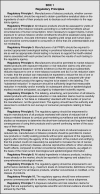Recommendations for the Appropriate Structure, Communication, and Investigation of Tobacco Harm Reduction Claims. An Official American Thoracic Society Policy Statement
- PMID: 30320525
- PMCID: PMC6943880
- DOI: 10.1164/rccm.201808-1443ST
Recommendations for the Appropriate Structure, Communication, and Investigation of Tobacco Harm Reduction Claims. An Official American Thoracic Society Policy Statement
Abstract
Rationale: The tobacco harm reduction literature is replete with vague language, far-reaching claims, and unwarranted certainty. The American Thoracic Society has increasingly recognized the need for a framework for reliably making such claims. Evidence-based standards improving the scientific value and transparency of harm reduction claims are expected to improve their trustworthiness, clarity, and consistency.
Methods: Experts from relevant American Thoracic Society committees identified key topic areas for discussion. Literature search strategy included English language articles across Medline, Google Scholar, and the Cochrane Collaborative databases, with expanded search terms including tobacco, addiction, smoking, cigarettes, nicotine, and harm reduction. Workgroup members synthesized their evidentiary summaries into a list of candidate topics suitable for inclusion in the final report. Breakout groups developed detailed content maps of each topic area, including points to be considered for suggested recommendations. Successive draft recommendations were modified using an iterative consensus process until unanimous approval was achieved. Patient representatives ensured the document's relevance to the lay public.
Results: Fifteen recommendations were identified, organized into four framework elements dealing with: estimating harm reduction among individuals, making claims on the basis of population impact, appropriately careful use of language, and ethical considerations in harm reduction.
Discussion: This statement clarifies important principles guiding valid direct and inferential harm reduction claims. Ideals for effective communication with the lay public and attention to unique ethical concerns are also delineated. The authors call for formal systems of grading harm reduction evidence and regulatory assurances of longitudinal surveillance systems to document the impact of harm reduction policies.
Keywords: addiction; e-cigarettes; prevention; smoking; tobacco dependence.
Figures


References
-
- Leone FT, Carlsen K-H, Folan P, Latzka K, Munzer A, Neptune E, et al. ATS Tobacco Action Committee; American Thoracic Society. An Official American Thoracic Society research statement: current understanding and future research needs in tobacco control and treatment. Am J Respir Crit Care Med. 2015;192:e22–e41. - PubMed
-
- National Center for Chronic Disease Prevention and Health Promotion (US) Office on Smoking and Health. The health consequences of smoking—50 years of progress: a report of the Surgeon General. Atlanta, GA: Centers for Disease Control and Prevention (US); 2014. [accessed 2017 Dec 13]. Available from: http://www.ncbi.nlm.nih.gov/books/NBK179276/ - PubMed
-
- Gerber Y, Myers V, Goldbourt U. Smoking reduction at midlife and lifetime mortality risk in men: a prospective cohort study. Am J Epidemiol. 2012;175:1006–1012. - PubMed
-
- Jia H, Lubetkin EI. Dose–response effect of smoking status on quality-adjusted life years among US adults aged 65 years and older. J Public Health (Oxf) 2017;39:e194–e201. - PubMed
Publication types
MeSH terms
Grants and funding
LinkOut - more resources
Full Text Sources
Miscellaneous

